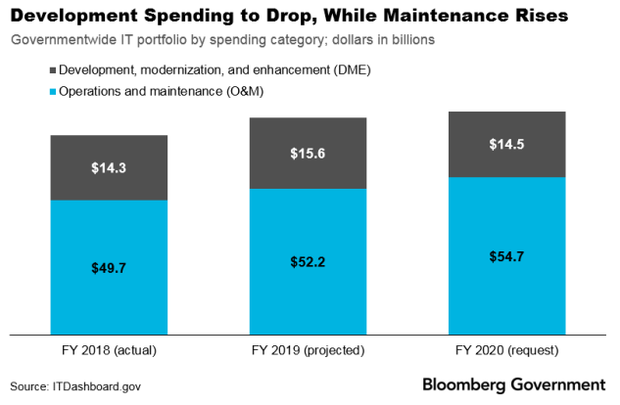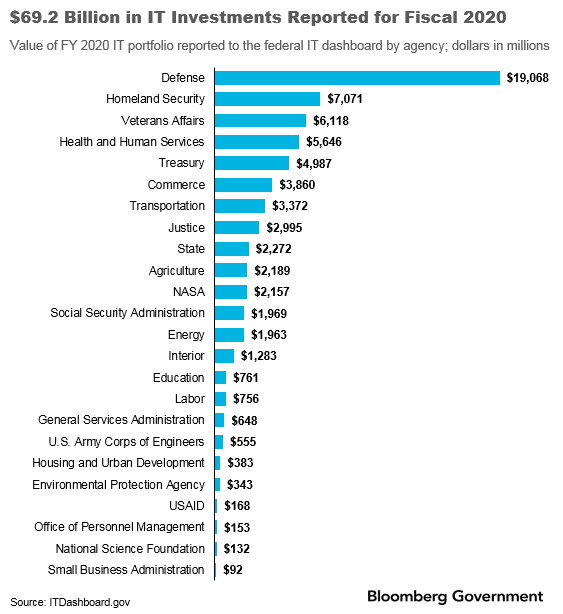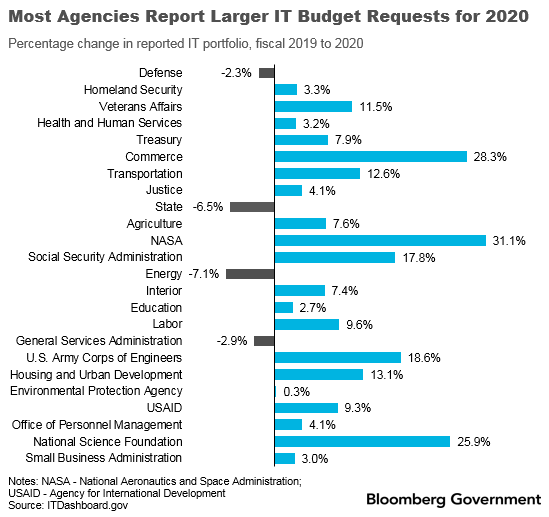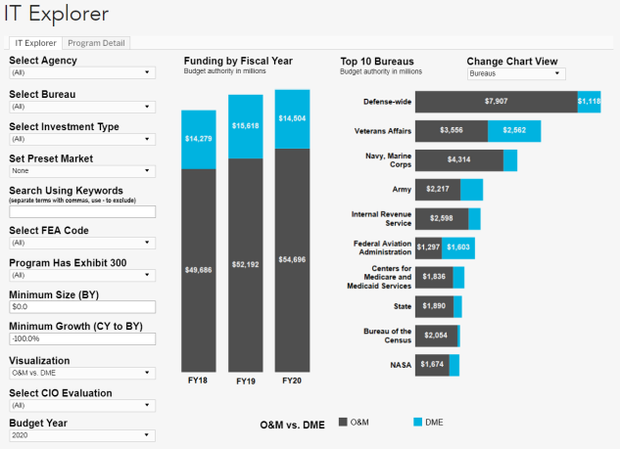IT Modernization Funding Expected to Fall in FY 2020
Governmentwide spending on information technology development, modernization, and enhancement, or DME, is expected to drop slightly in fiscal 2020 compared with investments in the previous year, according to a Bloomberg Government analysis.
In fiscal 2020, federal agencies are budgeting $14.5 billion for DME, or about 21 percent of their self-reported IT budgets. This represents a modest decrease from the $15.6 billion agencies allocated to IT DME for fiscal 2019, representing about 23 percent of IT budgets.
In fiscal 2020, agencies will allocate $54.7 billion for operating and maintaining existing IT investments, a category known as O&M. Agencies reported that they intend to invest $2.5 billion more on IT O&M than they planned in fiscal 2019.

The White House Office of Management and Budget has reported 7,285 fiscal 2020 IT projects valued at $69.2 billion to ITDashboard.gov, a repository for budget and performance data on the federal government’s IT investments. Data on the remaining $18.6 billion of the government’s $87.8 billion unclassified IT budget request was withheld on national security grounds.
Before this week, OMB had published data on only $37 billion of the president’s $88 billion fiscal 2020 IT budget request. In a departure from past precedent, OMB made a “data masking” decision not to report data on IT infrastructure, IT management, and cybersecurity programs, which typically make up about $30 billion of the governmentwide IT budget. Lawmakers and industry leaders criticized the decision. Rep. Gerry Connolly, chairman of House Government Oversight and Reform’s Government Operations subcommittee calling it “a move in the wrong direction and a mistake.”
On April 22, OMB published an additional 1,921 IT infrastructure, IT management, and cybersecurity programs — valued at a combined $32.3 billion — to the IT Dashboard, albeit in partial form. Some of the data on these investments remains incomplete, such as fields specifying the share of IT infrastructure investments agencies have set aside for cloud computing in fiscal 2020.
A senior administration official who asked not to be named because they were not authorized to speak on the record, told Bloomberg Government that gaps in the government’s IT portfolio data are due to agencies’ multiyear transition to the Technology Business Management, or TBM, framework. Because of the complications involved in adopting TBM, agencies’ chief information officers were not required to publicly report detailed data on sub-fields within IT infrastructure, management, and security during the fiscal 2020 budget cycle, the official said.
IT Reporting by Agency
The $69.2 billion in IT investments reported for fiscal 2020 is $3.3 billion more than agencies reported during the fiscal 2019 budget cycle.
The Defense Department leads all agencies with $19.1 billion in IT projects reported to the IT Dashboard. However, that figure accounts for only about 52 percent of the Pentagon’s $36.8 billion unclassified fiscal 2020 IT budget request. Data on the remaining 48 percent was withheld on national security grounds, about the same share that was unreported in fiscal 2019.

The $6.1 billion in IT projects that the Department of Veterans Affairs reported increased almost 12 percent from the $5.5 billion it reported during the fiscal 2019 budget cycle. The Commerce Department’s total was up more than 28 percent, to $3.9 billion in fiscal 2020.

Other agencies with substantial fiscal 2020 increases over reported spending in the 2019 request include the National Aeronautics and Space Administration (31 percent) and the National Science Foundation (26 percent). In total, eight agencies reported growth of more than 10 percent from fiscal 2019.
A few agencies reported decreases in IT investments compared with what they reported in fiscal 2019, including the State Department, Energy Department, and General Services Administration.
Normal shifts in budgets earmarked for specific IT projects may explain some of the large fluctuations that agencies are reporting. For example, the Pentagon’s 2.3 percent drop can be partially explained by a drop in allocations for its Healthcare Management System Modernization program. DOD may be transitioning away from developing the program and into maintaining it, shown by an increase in O&M funding requested. That reduction may also be due to increased oversight for the program, cost savings from reducing reliance on legacy systems, or collaboration with VA on an interoperable electronic health records system.
VA’s increase in part comes from elevated budgets for electronic health records modernization and IT operations programs. Commerce’s IT budget has ballooned as the 2020 census approaches.
Largest Governmentwide Projects
Many of the programs with the largest IT budget increases for fiscal 2020 are also the largest IT programs across federal agencies. VA’s Electronic Health Record Modernization and Commerce’s 2020 Decennial Census are the top IT projects in fiscal 2020. VA’s EHR modernization was the biggest program in the fiscal 2019 IT budget, while the census has risen from seventh-place in fiscal 2019.

Using BGOV
Bloomberg Government clients can use the IT Explorer to learn more about agency IT budgets and the programs that make up those budgets. To compare years, you can toggle between the fiscal 2020 and 2019 budget requests; filter by agency, bureau, market, keywords, and more; and click into individual programs for more details, including a description, associated contracts, incumbents, and chief information officer ratings.

BGOV will continue to update the IT Explorer to reflect the latest data, adding incumbent data for fiscal 2020’s budget request, cloud-related budget projections, and more. Check back periodically for enhancements.
To contact the analysts: Laura Criste in Washington, D.C. at lcriste@bgov.com; Chris Cornillie in Washington at ccornillie@bgov.com
To contact the editors responsible for this story: Daniel Snyder at dsnyder@bgov.com; Jodie Morris at jmorris@bgov.com